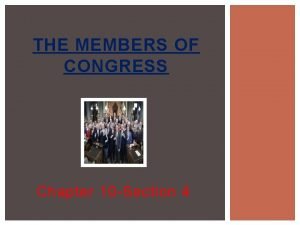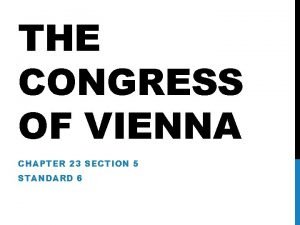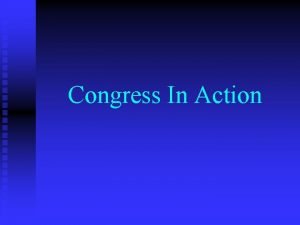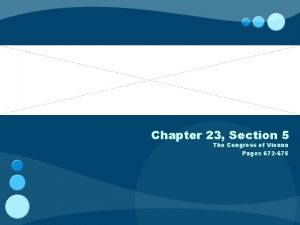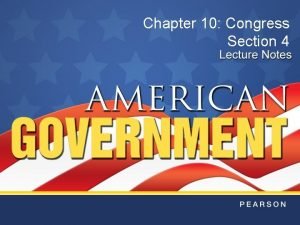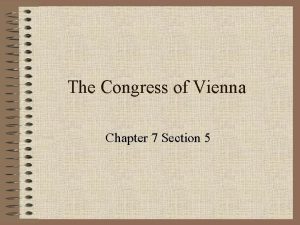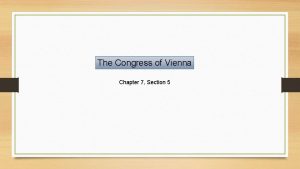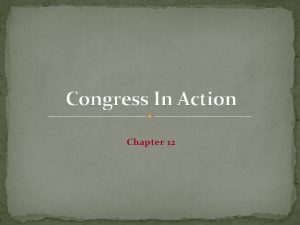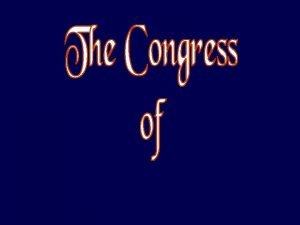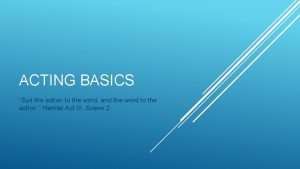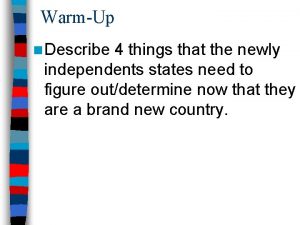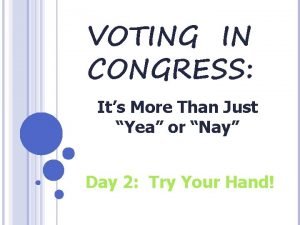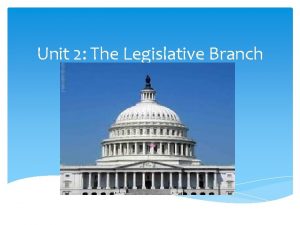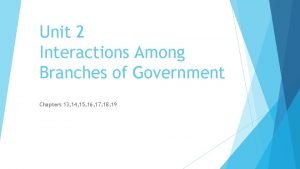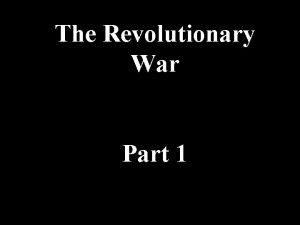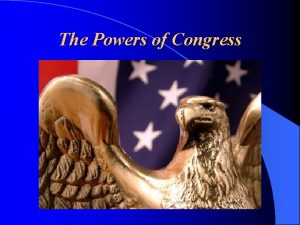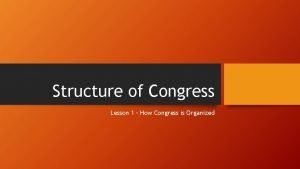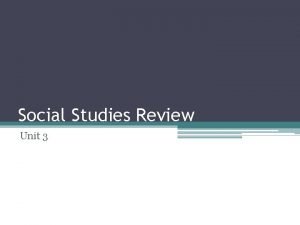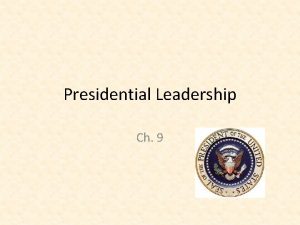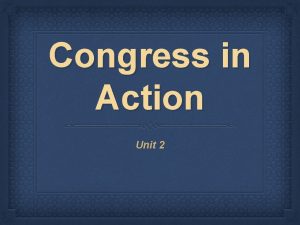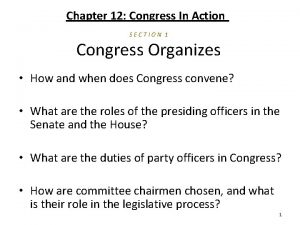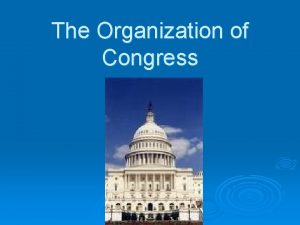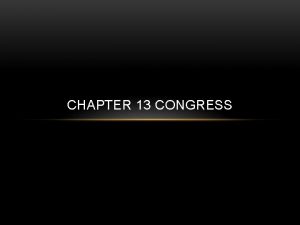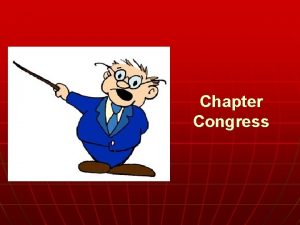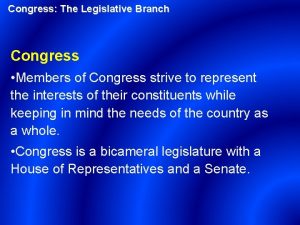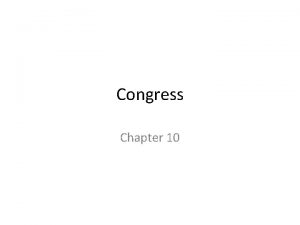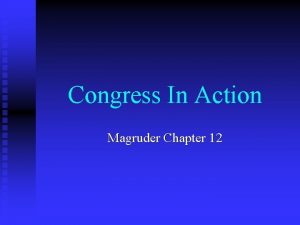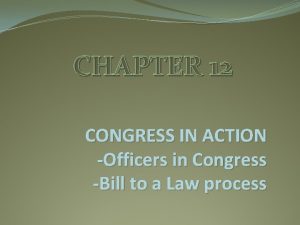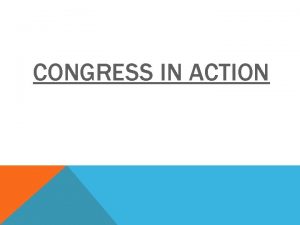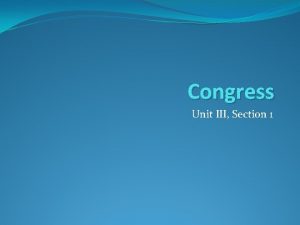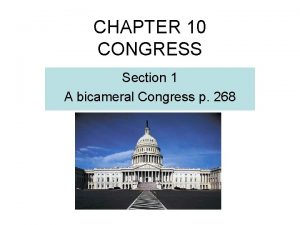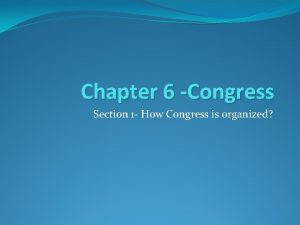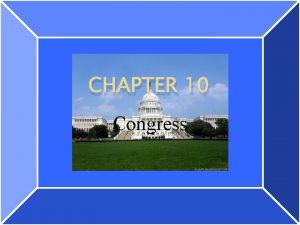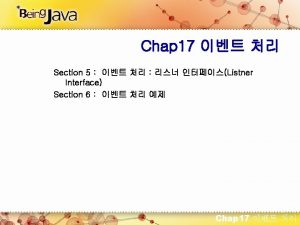Congress In Action Unit III Section 3 Section































- Slides: 31

Congress In Action Unit III, Section 3

Section I & II Congress Organizes & Committees In Congress

Opening Day January 3 � House � › Reestablishes order after every two year election › Reappoints the Speaker of the House �Majority party member �Sworn in first, then swears in House members › Rep. sit left/Dems. Sit right of the aisle › Other appointments made › Clerk, parliamentarian, chaplain, etc. › Members of committees appointed

…Continued � Senate › Continuous House � 1/3 of Senate up for election at a time › Swearing in of reelected or new members › Fill Senate organization vacancies

State of the Union Address � Occurs in weeks following term beginnings � Major political event � Pres. outlines/reports on, › Domestic issues › Foreign policy › Leg. recommendations � Ripples into a flood of executive legislation

Presiding Officers � Speaker of the House › Elected by constituency first (Representative) and then by majority party › Presides and keeps order › Keeps bill flow and committee process going › Follows VP in Pres. Line of Succession

…Continued � President of the Senate › VP holds this position › Not body member › Not necessarily a majority party member � President Pro Tem › Active in VP’s absence › Elected by Senators › Follows Speaker of the House in succession

Party Officers � Party Caucus › Closed meeting of party › Deals with party issues and organization � Floor Leadership › Legislative strategist › Majority/Minority Leadership › Whips �Leadership assistants �Liaison between rank-and-file and leadership �Truancy officers of the chambers

Committee Chairperson � Bulk of work done at committee level � Head of standing committee � Majority party member � Keeps bill flow going

Committee Assignments � Standing Committees › Used to keep similar bills together › House � 10 -75 member committees/1 -2 committees per member › Senate � 14 -28 member committees/3 -4 committees per member › Bill making process �Referred by Speaker or President of the Senate

…Continued � Committees vary by importance and interest � House-20, Senate-16 � Majority party holds most seats › Minority party still represented � Subcommittees › 150 › Used to look at specific interests

…Continued � Select Committees › Special committees › Approved by presiding officer › Investigatory power �Standing �Situational

Joint & Conference Committees � Joint › Made up of members of both houses �Economic �The Library �Printing �Taxation � Conference › Joint Body › Creates signable version of two house legislation �Both Houses must accept final document

Section III Highlights How a Bill Becomes a Law: The House

The First Steps � Bill › Proposed law form in both Houses › Proposed by chamber members but most often from executive branch › Ideas born from private citizen ideas › Standing committees › Broken up into private and public bills › Bill’s placed in hopper for consideration

Types of Resolutions � Joint Resolution › When passed have the force of law › Deal with unusual items › Used to propose constitutional amendments � Concurrent Resolutions › House & Senate act together › Does not have force of all, simple Congressional opinion

…Continued � Resolutions › From one house or another › No force of law › Used to introduce change to procedures � Rider › Included on an unrelated bill/resolution › Not likely to pass on own merit › Hope it will “ride” through on a well supported bill

The Bill in Committee � Bills first step in bill process � Analysis, amends, kills bills › Most bills die or are never acted on � Discharge petition › Forces bill quickly through committee � Subcommittees do most of the work › Investigates, holds public hearings, has junkets, etc. to gather information

…Continued � Committee Actions › Report bill favorably › Refuse to report the bill › Report bill in amended form › Report the bill with unfavorable recommendation › Report a committee bill › When scheduling floor debate the House has 5 calendars

House Rules � Rules › › Committee can, Limit floor debate Work toward killing a bill Allow bills certain privileges Suspend rules �House may move off established procedures

The Bill on the Floor � Committee of the Whole › Helps speed up bill process › Includes all House members › Less strict rules › Quorum needed to do regular House work �Only 100 needed for C of the W � Limited debate time to 1 hour � Leadership helps divide debate time � House members may “move the previous question”

…Continued � Voting › Series of votes for one bill › Vote on amendments, motions, etc � Four › › voting measures Voice voting Standing voting Teller voting Roll-call voting

Section IV The Bill in the Senate

Introducing the Bill � Bill is first given a number � Less formalized process than in the House � One committee calendar to work with � Majority floor leader determines bill’s final floor presentation

Rules for Debate � Unrestricted floor debate in the Senate � Senators may freely speak on any matter � “Previous question” cannot be moved � “Two-speech” rule › No Senator may speak more than twice on a given question/issue › Helps limit amount of time on debate

Filibuster � “Talk a bill to death” � Stalling tactic in the Senate › Seeking to kill or change a bill � Senator Huey Long (D, Louisiana) › 15 hours, 1935 � Strom Thurmond (R, South Carolina) › 24 hours, 15 minutes, 1957 › Pushed against Civil Rights

…Continued � 200 measures killed due to filibuster � Sheer threat may lead a bill to be changed or killed � Rules › Must stand › May not sit, lean on a desk, or walk about › Must speak

The Cloture Rule � Created in response to a 3 week filibuster in 1917 › Bill dealing with German U-boat attacks › 12 Senators were opposed, killed the bill › President Wilson and the public were outraged � Limits debate through special procedure › Limits debate to 30 hours › Must be then voted on

Final Steps

Conference Committees � Temporary joint committee � Deals with similar legislation that has disagreements � “Knits” together the two pieces › Often makes their own changes � Both houses usually agree on final bill › Powerful committee members › Usually occurs before adjournments

The President Acts � Four executive options on a bill › The President may sign it › The President may VETO it �Congress may overturn this action (rarely) �Line item veto- targets specific point › Allows bill to become law without signing it �No executive action for 10 days (minus Sunday) › Pocket Veto �Congress adjourns 10 within submitting bill �President does not act, the bill dies
 Hamlet act iii scene iii
Hamlet act iii scene iii Chapter 10 section 4 the members of congress
Chapter 10 section 4 the members of congress Chapter 23 section 5 the congress of vienna
Chapter 23 section 5 the congress of vienna Section 1 quiz congress organizes
Section 1 quiz congress organizes Chapter 7 section 5 the congress of vienna
Chapter 7 section 5 the congress of vienna Chapter 10 section 4 the members of congress
Chapter 10 section 4 the members of congress Chapter 7 section 5 the congress of vienna
Chapter 7 section 5 the congress of vienna The congress of vienna chapter 7 section 5
The congress of vienna chapter 7 section 5 Chapter 12 congress organizes
Chapter 12 congress organizes Chapter 23 section 5 the congress of vienna
Chapter 23 section 5 the congress of vienna Chapter 23 section 5 the congress of vienna
Chapter 23 section 5 the congress of vienna Unit 10, unit 10 review tests, unit 10 general test
Unit 10, unit 10 review tests, unit 10 general test Medias res
Medias res Character setting plot chart
Character setting plot chart Story mountain
Story mountain Exposition short story
Exposition short story Suit the action to the word the word to the action meaning
Suit the action to the word the word to the action meaning Unit action plan
Unit action plan Acrostic poem articles of confederation
Acrostic poem articles of confederation Does congress have the power to say no mail on saturdays
Does congress have the power to say no mail on saturdays Expressed powers
Expressed powers Congress formal and informal powers
Congress formal and informal powers Treaty of versailles 1815
Treaty of versailles 1815 First continental congress definition
First continental congress definition Non legislative duties of congress
Non legislative duties of congress The structure of congress lesson 2
The structure of congress lesson 2 Congress building
Congress building Siam physics congress
Siam physics congress Chapter 9 presidential leadership
Chapter 9 presidential leadership Non legislative powers of congress
Non legislative powers of congress Expressed implied and inherent powers
Expressed implied and inherent powers Pharmaceutical compliance congress
Pharmaceutical compliance congress

